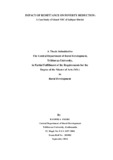Please use this identifier to cite or link to this item:
https://elibrary.tucl.edu.np/handle/123456789/2294| Title: | Impact of Remittance on Poverty Reduction |
| Other Titles: | A Case Study of Ghusel VDC of Lalitpur District |
| Authors: | Angbo, Radhika |
| Keywords: | Remittance;Poverty;Migrant remittance;Economic status |
| Issue Date: | 2016 |
| Publisher: | Central Department of Rural Development Tribhuvan University, Kathmandu |
| Abstract: | This Study entitled Impact of Remittance on Poverty Reduction (A Case Study of Ghusel VDC of Lalitpur District, Nepal) was conducted with the objectives of describing the present socio-economic status, finding socio-cultural, economic and other impact of remittance to the households and assess the evolving practices on remittance in Ghusel VDC (specially in ward no: 2, 4, 5 and 6) of Lalitpur District. This study is mainly based in the primary information and the data were collected using the techniques of household survey with the help of questionnaire and interview. There were 317 households (HHs) in the VDC. Of the total households, 50 HHs that are/were receiving remittance money for a period of 2 years or more was selected as the sample for the study. During the study it was found that Tamang (53%) were the main ethnic group in the study area. Agriculture (92%) was the main occupation, the average family size of the sample HHs were 4.4 persons per family, average literacy rate 68%, 41.67% sample HHs can support expenditure by their income only for 6 months (before receiving remittance income). 82% of the migrant labors are male, 32% migrant labors went to Malaysia, 52.63% labors going to work are unskilled, 56% sample HHs believed that the main reason to go was to pay debts. 52.77% sample HHs paid an amount of above NRs. 100,000 while going abroad. 70% sample HHs send the remittance through the medium of Financial Institutions 'Bank, finance Money transfer etc., 52.77% sample HHs received an amount of NRs. 300,000 to 500,000 as remittance per year and 52.77% sample HHs had an annual saving of NRs. above 100,000, 40.14% of the total remittance received is used in normal HHs expenditure. 35HHs deposited the net saving in self-help groups. Similarly there was increment in the HHs going for regular health check-up by 13%, the people going to study in schools and colleges increased by 16.39%, 102 HHs sent their children to boarding schools after the flow of remittance in the study area but it was also found that, some of the HHs were engaged in unsocial activities like gambling, drug abuse, etc. From the study we can conclude that all the households who are/were receiving remittance are getting benefit. Their access to health, education and economy has increased. By the use of remittance income, there has been investment in the income generating activities resulting in the regular flow of money in the HHs and motivation for entrepreneurship development at local level has helped positively in reduction of poverty and in holistic development of rural areas. All HHs were very positive towards remittance income. They suggested that focus should be in easy availability of loan facilities at low price and providing skills and trainings before going as migrant labor. |
| URI: | http://elibrary.tucl.edu.np/handle/123456789/2294 |
| Appears in Collections: | Rural Development |
Items in DSpace are protected by copyright, with all rights reserved, unless otherwise indicated.

